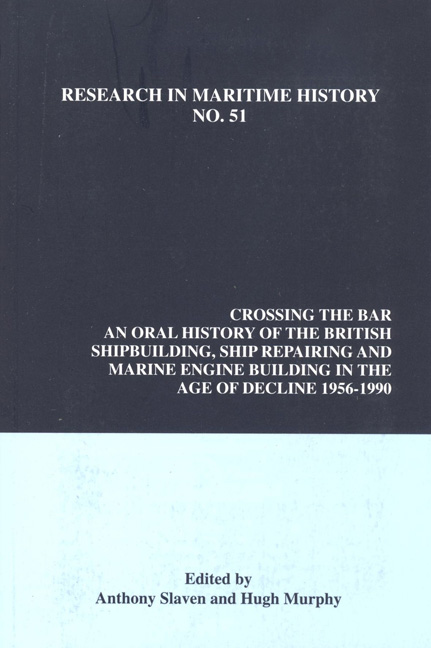 Crossing the Bar
Crossing the Bar Book contents
- Frontmatter
- Contents
- About the Authors
- Dedication
- Preface: A Shipbuilding Libretto
- Introduction
- Interviews
- Lower Clyde
- Upper Clyde
- The Tyne
- The Wear
- 23 Arthur Storey, NEM, Doxford and Vickers Engineers, Austin and Pickersgill
- 24 Ken Douglas, Wm. Gray, Austin and Pickersgill, UCS, British Shipbuilders Plc
- 25 Derek Kimber, Fairfield, Harland and Wolff, Austin and Pickersgill
- Barrow-in-Furness
- The South Coast
- The Humber
- Belfast
- British Shipbuilding Industry Officials
- The Trade Unions
- The Civil Servants, Board of Trade, Shipbuilding Enquiry Committee, Shipbuilding Industry Board, Ministry of Technology, Department of Trade and Industry, Department of Industry
- The Politicians
- Interviews British Shipbuilders Plc
- Conclusion
- Select Bibliography
23 - Arthur Storey, NEM, Doxford and Vickers Engineers, Austin and Pickersgill
from The Wear
- Frontmatter
- Contents
- About the Authors
- Dedication
- Preface: A Shipbuilding Libretto
- Introduction
- Interviews
- Lower Clyde
- Upper Clyde
- The Tyne
- The Wear
- 23 Arthur Storey, NEM, Doxford and Vickers Engineers, Austin and Pickersgill
- 24 Ken Douglas, Wm. Gray, Austin and Pickersgill, UCS, British Shipbuilders Plc
- 25 Derek Kimber, Fairfield, Harland and Wolff, Austin and Pickersgill
- Barrow-in-Furness
- The South Coast
- The Humber
- Belfast
- British Shipbuilding Industry Officials
- The Trade Unions
- The Civil Servants, Board of Trade, Shipbuilding Enquiry Committee, Shipbuilding Industry Board, Ministry of Technology, Department of Trade and Industry, Department of Industry
- The Politicians
- Interviews British Shipbuilders Plc
- Conclusion
- Select Bibliography
Summary
In September 1920, I went to work at NEM. I was with them for thirty-two years. In 1953, I went to Doxford to take over as Director and General Manager of their Engine Works. I stayed there for five years until joining Vickers at Barrow to take charge of their engineering side at a time when they were just starting on their nuclear submarines. I left Barrow in 1968, and joined Austin and Pickersgill as a non executive director. When the then Chairman, Charles Longbottom, and the General Manager, Jim Gilfillan left to join Court Line, I took over as Managing Director until I got Derek Kimber to join as Chairman and Managing Director. I carried on at Austin and Pickersgill until 1976, where I assisted in the formation of A. and P. Appledore, and have been associated with them ever since.
When I went to Doxford, we had huge marketing potential for the Doxford engine. I put in an application for the extension of Doxford's engine building capacity, but it was vetoed by Dr. J. Ramsay Gebbie as soon as Dr. Andre, the Chairman at the time who had always solidly backed me as director, retired. Doxford engines were the best, and in the period after the war it was out selling the Sulzer engine. If I had been allowed to develop the engine as I wanted to and to extend production of it, it could have remained the best selling engine. But, Dr. J. Ramsay Gebbie put the block on it in 1957. He told me that I could forget about extending the Engine Works because Doxford built ships. However, the shipyard could only produce six ships per year. With the market values at that time, the maximum profit the shipyard could possibly make was about £350,000. Whereas in 1957, I turned in a profit of about £1.6 million on engines, we were producing eighteen engines per year, and they could only build six ships. So the decision to halt development and innovation on Doxford engines was down to Dr. J. Ramsay Gebbie. This can not be overemphasised. You can find my statements to that effect in The Transactions of the North East Coast Institution of Engineers and Shipbuilders. This was very important for the future of marine engine building in Britain.
- Type
- Chapter
- Information
- Crossing the BarAn Oral History of the British Shipbuilding, Ship Repairing and Marine Engine-Building Industries in the Age of Decline, 1956-1990, pp. 91 - 93Publisher: Liverpool University PressPrint publication year: 2013


